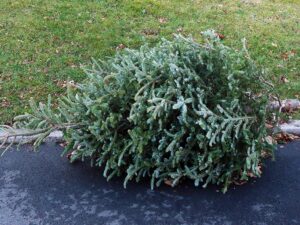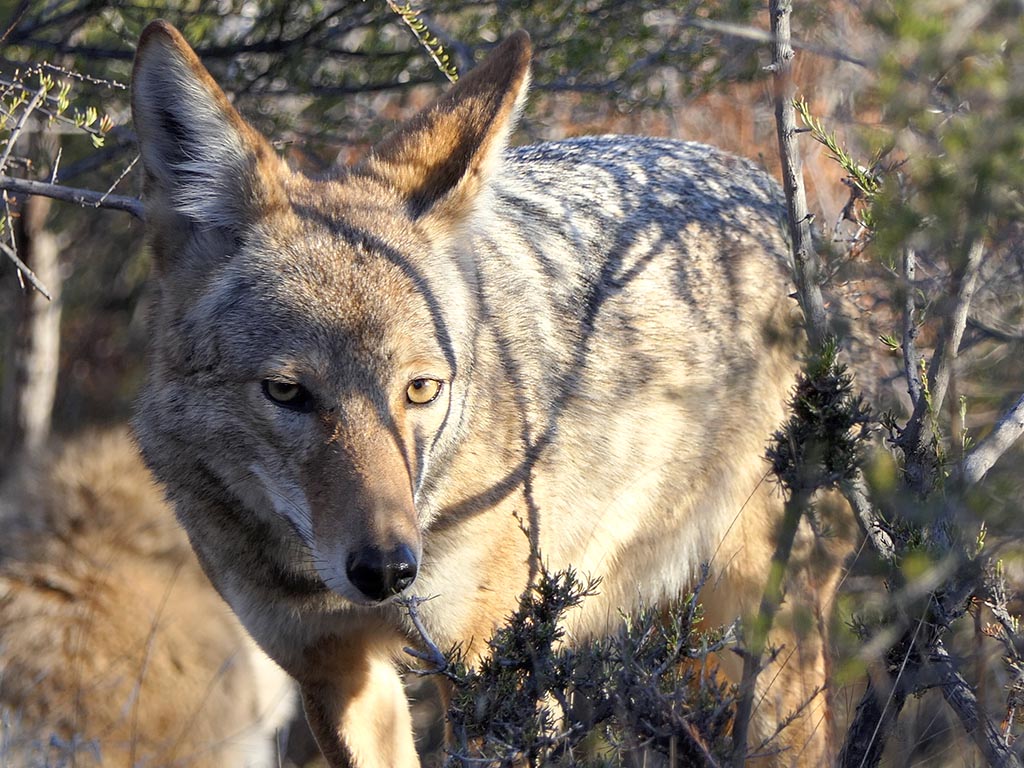गाँव खूबसूरत जंगलों से घिरा हुआ है, यानी हम सभी प्रकार की वन्यजीव प्रजातियों के निकट रहते हैं और उनके निकट संपर्क में आते हैं। कुछ लोग वन्यजीवों को उपद्रव या ख़तरा मानते हैं; तो कुछ लोग जानवरों को देखना पसंद करते हैं।
यहां बताया गया है कि रैटलस्नेक, कोयोट, मधुमक्खियों और अन्य वन्यजीवों के साथ शांतिपूर्वक और सावधानीपूर्वक कैसे सह-अस्तित्व में रहा जाए।
रैटलस्नेक

रैटलस्नेक के काटने असामान्य हैं, लेकिन इससे गंभीर चोट लग सकती है या इससे भी बदतर स्थिति हो सकती है। अमेरिकी खाद्य एवं औषधि प्रशासन के अनुसार, 8,000 लोग अमेरिका में हर साल कई लोग विषैले साँपों द्वारा काटे जाते हैं।
नागइनका सिर त्रिकोणीय होता है और पूँछ के सिरे पर एक खड़खड़ाहट होती है। इन्हें बिना खड़खड़ाहट के तभी देखा जा सकता है जब वह टूटी हुई हो। यही बात इन्हें अन्य समान दिखने वाले साँपों, जैसे विषहीन गोफर साँपों से अलग करती है। इनके शल्क चिकने नहीं, बल्कि "कीलदार" होते हैं—उभरे हुए और बनावट वाले—और ये चमकदार नहीं, बल्कि मैट होते हैं। ये मिट्टी के रंगों में रंगे होते हैं और इनके शल्कों का पैटर्न हीरे जैसा होता है।
भयावह खड़खड़ाहट और काटे जाने के डर के बावजूद, रैटलस्नेक आक्रामक नहीं होते और लोगों से बचते हैं। जब वे काटते भी हैं, तो अक्सर इसलिए क्योंकि उन्हें कोई आश्चर्य हुआ होता है।
हालाँकि, आपको हमेशा खड़खड़ाहट वाले साँपों से चेतावनी नहीं मिलेगी। वे हमला करने से पहले चुप रह सकते हैं और यह हमला एक "सूखा दंश" भी हो सकता है, या ऐसा भी हो सकता है जिसमें साँप की ऊर्जा बचाने के लिए ज़हर न डाला गया हो। फिर भी, सभी दंशों को गंभीरता से लेना चाहिए।
इसके अलावा, साँप लगातार गर्म या ठंडे तापमान के प्रभाव को संतुलित करने के लिए अपने व्यवहार को समायोजित कर लेते हैं।
ठंडी रात के बाद, वे अपने शरीर का तापमान बढ़ाने के लिए सुबह-सुबह धूप सेंकते हैं। लेकिन बसंत और गर्मियों के महीनों में ज़्यादा गर्मी से बचने के लिए, वे सुबह, शाम और रात में ज़्यादा सक्रिय रहते हैं।
पैदल चलते/लंबी पैदल यात्रा करते समय:
- सतर्क रहें.
- पैदल यात्रा के रास्तों पर रहें जहां आपको साँप देखने और उससे बचने की बेहतर संभावना होगी।
- अगर आपको कोई दिखे, तो घबराएँ नहीं। अगर उन्हें पर्याप्त जगह दी जाए और आप उन्हें उकसाएँ या उनके पास न जाएँ, तो वे पीछे हट जाएँगे।
- अपने पालतू जानवर को पट्टे पर रखें। उन्हें साँपों द्वारा काटे जाने का ख़तरा ज़्यादा होता है क्योंकि वे नए इलाकों में जाते समय ज़मीन को सूँघते हैं।
- मजबूत जूते और लंबी पैंट पहनें।
- सुनिश्चित करें कि जंगल में पोते-पोतियों के पास भी उचित जूते हों और लंबी पैदल यात्रा के दौरान उन पर नजर रखें।
- अकेले पैदल यात्रा न करें।
- अच्छी तरह से उपयोग किए जाने वाले मार्गों पर ही चलें।
- दरवाजे पर सावधानी से कदम रखें; सांप इमारतों के किनारों पर रेंगना पसंद करते हैं।
- मृत साँप के पास न जाएँ और न ही उससे छेड़छाड़ करें, क्योंकि वह अभी भी विष छोड़ सकता है।
यदि रैटलस्नेक ने काट लिया तो:
- शांत रहें।
- शीघ्रता से कार्य करें।
- प्रभावित क्षेत्र में संभावित सूजन को बढ़ाने वाली किसी भी वस्तु को हटा दें, जैसे घड़ियां, कंगन और जूते।
- जितनी जल्दी हो सके अस्पताल पहुंचें या 911 पर कॉल करें।
- विष को चूसने का प्रयास न करें।
- टूर्निकेट न लगायें।
- काटने वाले स्थान पर बर्फ न रखें।
- घाव के अन्दर या आस-पास कोई कट न लगाएँ।
काटे गए पालतू जानवर को कैसे संभालें:
- साँप को अकेला छोड़ दो।
- अपने पालतू जानवर को जितनी जल्दी हो सके साँप से दूर ले जाएँ, ध्यान रखें कि इससे साँप को कोई खतरा न हो।
- तुरंत आपातकालीन पशुचिकित्सक को बुलाएं।
- जब तक आप आगे के निर्देशों की प्रतीक्षा कर रहे हों, अपने पालतू जानवर को आरामदायक स्थिति में रखें, आदर्श रूप से काटने की जगह को हृदय से नीचे रखें।
- अपने पालतू जानवर को तुरंत पशु चिकित्सक के पास ले जाएं।
- कैनाइन रैटलस्नेक टीकों के बारे में अपने पशुचिकित्सक से बात करें।
काइओट
गाँव में कोयोट का दिखना आम बात है, क्योंकि हम उनके प्राकृतिक आवास के पास ही स्थित हैं और उन्हें इंसानों से बहुत कम या बिल्कुल भी डर नहीं लगता। किसी मुठभेड़ से कैसे निपटना है, यह जानें। पिल्लों के जन्म के बाद पहले कुछ महीनों के दौरान, मादा कोयोट अपने बच्चों के प्रति ज़्यादा सुरक्षात्मक होती हैं।
हालाँकि आमतौर पर कोयोट हमारे लिए ख़तरा नहीं होते, लेकिन अगर उन्हें धमकाया जाए या घेर लिया जाए, तो वे रक्षात्मक व्यवहार दिखाते हैं, इसलिए ज़रूरी है कि आप अपने और कोयोट के बीच एक आरामदायक दूरी बनाए रखें। अगर आपका सामना किसी ऐसे कोयोट से होता है जो आक्रामक व्यवहार करता है, तो आप शायद उसके शिकार या परिवार के बहुत करीब हैं और आपको अपने और जानवर के बीच "आरामदायक क्षेत्र" बढ़ाने की ज़रूरत है।
ओसी कम्युनिटी रिसोर्सेज, ओसी एनिमल केयर और अन्य पशु एवं वन्यजीव सरकारी एजेंसियों के अनुसार, शहरी कोयोटों का उन्मूलन और/या स्थानांतरण अप्रभावी है। हालाँकि, सुरक्षात्मक उपाय अपनाकर, आप उपद्रव को कम कर सकते हैं और कोयोटों के कारण होने वाले छोटे पालतू जानवरों के नुकसान को रोक सकते हैं।
सूचना और संसाधन
लगुना बीच पुलिस विभाग का पशु सेवा प्रभाग गांव में वन्यजीव स्थितियों पर प्रतिक्रिया करता है। मुठभेड़ों की रिपोर्ट करने के लिए, 949-497-0701 पर कॉल करें या ईमेल करें कोयोट्स@lagunabeachcity.net.
कृपया गांव के वन्यजीवों को खाना न खिलाएं
कैलिफ़ोर्निया में वन्यजीवों को खाना खिलाना गैरकानूनी है। यहाँ गाँव में, दोनों पक्ष जानवरों को खाना खिलाने या आकर्षित करने पर भी प्रतिबंध लगाते हैं। तीसरे, संकल्प 03-16-117, आँगन, बालकनी, हवादार रास्तों और पैदल मार्गों की देखभाल और रखरखाव में कहा गया है, "... ऐसी वस्तुएँ जो पड़ोसियों के लिए परेशानी का कारण बनती हैं, उन्हें सार्वजनिक क्षेत्रों या सीमित सार्वजनिक क्षेत्रों में नहीं रखा जाना चाहिए। उदाहरण के लिए... भोजन या पानी, जो पक्षियों, कीड़ों या अन्य जानवरों को आकर्षित कर सकता है..."
संयुक्त राज्य अमेरिका में, संकल्प 01-03-134, आँगन, बालकनियों, हवादार रास्तों और पैदल मार्गों की देखभाल एवं रखरखाव, में कहा गया है, "ऐसी वस्तुएँ जो पड़ोसियों के लिए परेशानी का कारण बनती हैं, उन्हें साझा क्षेत्रों या सीमित साझा क्षेत्रों में नहीं रखा जाना चाहिए। उदाहरण के लिए, लेकिन इन्हीं तक सीमित नहीं, घुसपैठ करने वाली विंड चाइम, परावर्तक वस्तुएँ, भोजन या पानी जो पक्षियों, कीड़ों, कृन्तकों या अन्य जानवरों को आकर्षित कर सकते हैं।"
अगर आप अपने पड़ोसियों को वन्यजीवों को खाना खिलाते हुए देखें, तो कृपया सुरक्षा विभाग को 949-580-1400 पर कॉल करें। शिकायतें गुमनाम भी हो सकती हैं।
अपने आप को, अपने पालतू जानवरों और अपनी संपत्ति को वन्यजीवों से बचाने के लिए निम्नलिखित कदम उठाएँ:
- कोयोट या किसी भी जंगली जानवर को कभी भी खाना न खिलाएँ
- संभावित भोजन और पानी के स्रोतों को हटा दें, जैसे गिरे हुए फल और खड़ा पानी
- पालतू जानवरों को घर के अंदर ही खाना खिलाएं
- बिल्लियों और छोटे कुत्तों को घर के अंदर रखें या बाहर जाने पर उन पर कड़ी निगरानी रखें
- कचरे को ढके हुए भारी कंटेनरों में रखें
- यार्ड क्षेत्रों और आँगन को संभावित आश्रय, जैसे कि मोटी झाड़ियों और/या खरपतवारों से मुक्त रखें
बीईईएस

जब मधुमक्खियां गांव में किसी अवांछित स्थान (जमीन, हवेली के पास पेड़ या झाड़ी, बालकनी, आदि) पर घर बनाने की उम्मीद में झुंड बनाती हैं, तो निवासी 949-597-4600 पर कॉल करके या ईमेल करके निवासी सेवाओं को मधुमक्खियों के झुंड की सूचना दे सकते हैं। निवासीसेवा@vmsinc.orgकर्मचारी छत्ते को हटाने के लिए किसी विशेषज्ञ को सूचित करेंगे। कुछ मामलों में, छत्ते को किसी सुरक्षित स्थान पर स्थानांतरित किया जा सकता है, जहाँ मधुमक्खियाँ लोगों को परेशान किए बिना पौधों और पेड़ों का परागण कर सकेंगी।
गांव की अधिक खबरों के लिए नीचे दिए गए टैग "गांव में क्या चल रहा है" पर क्लिक करें।





